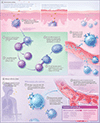Management of Food Allergies and Food-Related Anaphylaxis
- PMID: 38349368
- PMCID: PMC11060332
- DOI: 10.1001/jama.2023.26857
Management of Food Allergies and Food-Related Anaphylaxis
Abstract
Importance: An estimated 7.6% of children and 10.8% of adults have IgE-mediated food-protein allergies in the US. IgE-mediated food allergies may cause anaphylaxis and death. A delayed, IgE-mediated allergic response to the food-carbohydrate galactose-α-1,3-galactose (alpha-gal) in mammalian meat affects an estimated 96 000 to 450 000 individuals in the US and is currently a leading cause of food-related anaphylaxis in adults.
Observations: In the US, 9 foods account for more than 90% of IgE-mediated food allergies-crustacean shellfish, dairy, peanut, tree nuts, fin fish, egg, wheat, soy, and sesame. Peanut is the leading food-related cause of fatal and near-fatal anaphylaxis in the US, followed by tree nuts and shellfish. The fatality rate from anaphylaxis due to food in the US is estimated to be 0.04 per million per year. Alpha-gal syndrome, which is associated with tick bites, is a rising cause of IgE-mediated food anaphylaxis. The seroprevalence of sensitization to alpha-gal ranges from 20% to 31% in the southeastern US. Self-injectable epinephrine is the first-line treatment for food-related anaphylaxis. The cornerstone of IgE-food allergy management is avoidance of the culprit food allergen. There are emerging immunotherapies to desensitize to one or more foods, with one current US Food and Drug Administration-approved oral immunotherapy product for treatment of peanut allergy.
Conclusions and relevance: IgE-mediated food allergies, including delayed IgE-mediated allergic responses to red meat in alpha-gal syndrome, are common in the US, and may cause anaphylaxis and rarely, death. IgE-mediated anaphylaxis to food requires prompt treatment with epinephrine injection. Both food-protein allergy and alpha-gal syndrome management require avoiding allergenic foods, whereas alpha-gal syndrome also requires avoiding tick bites.
Conflict of interest statement
Figures



References
Publication types
MeSH terms
Substances
Supplementary concepts
Grants and funding
LinkOut - more resources
Full Text Sources
Medical

